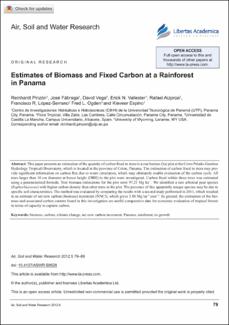| dc.contributor.author | Pinzón, Reinhardt | |
| dc.contributor.author | Fábrega, José | |
| dc.contributor.author | Vega, David | |
| dc.contributor.author | Vallester, Erick | |
| dc.contributor.author | Aizprúa, Rafael | |
| dc.contributor.author | López-Serrano, Francisco | |
| dc.contributor.author | Ogden, Fred | |
| dc.contributor.author | Espino, Kleveer | |
| dc.date.accessioned | 2018-03-22T15:06:35Z | |
| dc.date.accessioned | 2018-03-22T15:06:35Z | |
| dc.date.available | 2018-03-22T15:06:35Z | |
| dc.date.available | 2018-03-22T15:06:35Z | |
| dc.date.issued | 2012-10-03 | |
| dc.date.issued | 2012-10-03 | |
| dc.identifier | http://journals.sagepub.com/doi/abs/10.4137/ASWR.S9528 | |
| dc.identifier.issn | 1178-6221 | |
| dc.identifier.uri | http://ridda2.utp.ac.pa/handle/123456789/4446 | |
| dc.identifier.uri | http://ridda2.utp.ac.pa/handle/123456789/4446 | |
| dc.description | This paper presents an estimation of the quantity of carbon fixed in trees in a one hectare (ha) plot at the Cerro Pelado-Gamboa
Hydrology Tropical Observatory, which is located in the province of Colon, Panama. The estimation of carbon fixed in trees may provide significant information on carbon flux due to water circulation, which may ultimately enable evaluation of the carbon cycle. All trees larger than 10 cm diameter at breast height (DBH) in the plot were investigated. Carbon fixed within these trees was estimated using a parameterized formula. Tree biomass estimations for the plot were 97.21 Mg ha−1. We identified a rare arboreal pear species (Euphorbiaceous) with higher carbon density than other trees in the plot. The presence of this apparently unique species may be due to specific soil characteristics. The method was evaluated by comparing the results with a second study performed in 2011, which resulted in an estimate of net new carbon (biomass) increment (NNCI), which gives 3.88 Mg ha−1
year−1. In general, the estimation of the biomass and associated carbon content found in this investigation are useful comparative data for economic evaluation of tropical forests in terms of capacity to capture carbon. | |
| dc.description.abstract | This paper presents an estimation of the quantity of carbon fixed in trees in a one hectare (ha) plot at the Cerro Pelado-Gamboa
Hydrology Tropical Observatory, which is located in the province of Colon, Panama. The estimation of carbon fixed in trees may provide significant information on carbon flux due to water circulation, which may ultimately enable evaluation of the carbon cycle. All trees larger than 10 cm diameter at breast height (DBH) in the plot were investigated. Carbon fixed within these trees was estimated using a parameterized formula. Tree biomass estimations for the plot were 97.21 Mg ha−1. We identified a rare arboreal pear species (Euphorbiaceous) with higher carbon density than other trees in the plot. The presence of this apparently unique species may be due to specific soil characteristics. The method was evaluated by comparing the results with a second study performed in 2011, which resulted in an estimate of net new carbon (biomass) increment (NNCI), which gives 3.88 Mg ha−1
year−1. In general, the estimation of the biomass and associated carbon content found in this investigation are useful comparative data for economic evaluation of tropical forests in terms of capacity to capture carbon. | en_US |
| dc.language | eng | |
| dc.language.iso | eng | en_US |
| dc.rights | https://creativecommons.org/licenses/by-nc-sa/4.0/ | |
| dc.rights | info:eu-repo/semantics/openAccess | |
| dc.subject | Biomass | en_US |
| dc.subject | Carbon | en_US |
| dc.subject | climate change | en_US |
| dc.subject | net new carbon increment | en_US |
| dc.subject | Panama | en_US |
| dc.subject | Rainforest | en_US |
| dc.subject | re-growth | en_US |
| dc.subject | Biomass | |
| dc.subject | Carbon | |
| dc.subject | climate change | |
| dc.subject | net new carbon increment | |
| dc.subject | Panama | |
| dc.subject | Rainforest | |
| dc.subject | re-growth | |
| dc.title | Estimates of Biomass and Fixed Carbon at a Rainforest in Panama | en_US |
| dc.type | info:eu-repo/semantics/article | |
| dc.type | info:eu-repo/semantics/publishedVersion | |
